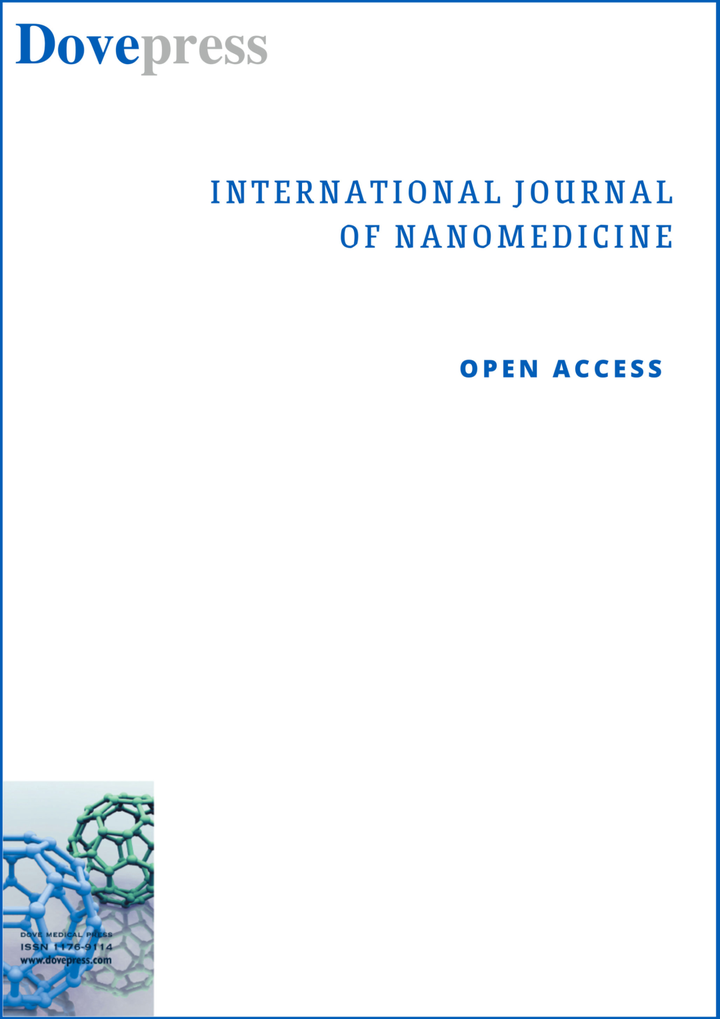通过光声/超声双模态 cRGD 纳米分子探针识别动脉粥样硬化斑块的脆弱性
IF 6.6
2区 医学
Q1 NANOSCIENCE & NANOTECHNOLOGY
引用次数: 0
摘要
目的探讨利用cRGD-GNR-PFP-NPs通过光声/超声双模态成像评估动脉粥样硬化斑块小鼠模型中斑块脆弱性的可行性:方法:采用双乳液溶剂蒸发和碳化二亚胺法制备了一种纳米分子探针,其中包含包覆有环状 Arg-Gly-Asp (cRGD) 多肽的金纳米棒(GNRs)和全氟戊烷(PFP)。研究表征了纳米分子探针的形态、粒度、电位、cRGD 共轭和吸收特征,以及其体外相变和光声/超声双模态成像特性。利用体内荧光成像确定了 cRGD-GNR-PFP-NPs 在脂蛋白 E 缺乏(ApoE-/-)动脉粥样硬化斑块模型小鼠体内的分布,确定了最佳成像时间,并对动脉粥样硬化斑块中表达的整合素 αvβ 3 进行了光声/超声双模态分子成像。结果:cRGD-GNR-PFP-NPs 呈球形,粒径适当(平均约 258.03± 6.75 nm),分散均匀,电位约为 - 9.36± 0.53 mV。cRGD-GNR-PFP-NPs 在非激发态非常稳定,但在低强度聚焦超声(LIFU)作用下很容易发生相变,具有良好的光声/超声双模态成像能力。以高脂肪饮食喂养 20 周的小鼠患有明显的高脂血症,斑块更大、更脆弱。经体内荧光成像测定,cRGD-GNR-PFP-NPs可特异性地靶向这些斑块,且纳米分子探针的富集度随斑块脆弱性的增加而增加;高脂组斑块的光声/超声信号更强。病理评估结果与cRGD-GNR-PFP-NPs斑块积聚、整合素αvβ 3表达和斑块易损性结果一致:结论:成功制备了一种相变光声/超声双模式cRGD纳米分子探针,可用于安全有效地识别斑块的脆弱性。 关键词:动脉粥样硬化;脆弱性;光声;超声;低强度聚焦超声本文章由计算机程序翻译,如有差异,请以英文原文为准。
Identification of the Vulnerability of Atherosclerotic Plaques by a Photoacoustic/Ultrasonic Dual-Modal cRGD Nanomolecular Probe
Objective: To explore the feasibility of using cRGD-GNR-PFP-NPs to assess plaque vulnerability in an atherosclerotic plaque mouse model by dual-modal photoacoustic/ultrasonic imaging.
Methods: A nanomolecular probe containing gold nanorods (GNRs) and perfluoropentane (PFP) coated with the cyclic Arg-Gly-Asp (cRGD) peptide were prepared by double emulsion solvent evaporation and carbodiimide methods. The morphology, particle size, potential, cRGD conjugation and absorption features of the nanomolecular probe were characterized, along with its in vitro phase transformation and photoacoustic/ultrasonic dual-modal imaging properties. In vivo fluorescence imaging was used to determine the distribution of cRGD-GNR-PFP-NPs in vivo in apolipoprotein E-deficient (ApoE−/−) atherosclerotic plaque model mice, the optimal imaging time was determined, and photoacoustic/ultrasonic dual-modal molecular imaging of integrin αvβ 3 expressed in atherosclerotic plaques was performed. Pathological assessments verified the imaging results in terms of integrin αvβ 3 expression and plaque vulnerability.
Results: cRGD-GNR-PFP-NPs were spherical with an appropriate particle size (average of approximately 258.03± 6.75 nm), a uniform dispersion, and a potential of approximately − 9.36± 0.53 mV. The probe had a characteristic absorption peak at 780~790 nm, and the surface conjugation of the cRGD peptide reached 92.79%. cRGD-GNR-PFP-NPs were very stable in the non-excited state but very easily underwent phase transformation under low-intensity focused ultrasound (LIFU) and had excellent photoacoustic/ultrasonic dual-modal imaging capability. Mice fed a high-fat diet for 20 weeks had obvious hyperlipidemia with larger, more vulnerable plaques. These plaques could be specifically targeted by cRGD-GNR-PFP-NPs as determined by in vivo fluorescence imaging, and the enrichment of nanomolecular probe increased with the increasing of plaque vulnerability; the photoacoustic/ultrasound signals of the plaques in the high-fat group were stronger. The pathological assessments were in good agreement with the cRGD-GNR-PFP-NPs plaque accumulation, integrin αvβ 3 expression and plaque vulnerability results.
Conclusion: A phase variant photoacoustic/ultrasonic dual-modal cRGD nanomolecular probe was successfully prepared and can be used to identify plaque vulnerability safely and effectively.
Keywords: atherosclerosis, vulnerability, photoacoustic, ultrasound, low-intensity focused ultrasound
Methods: A nanomolecular probe containing gold nanorods (GNRs) and perfluoropentane (PFP) coated with the cyclic Arg-Gly-Asp (cRGD) peptide were prepared by double emulsion solvent evaporation and carbodiimide methods. The morphology, particle size, potential, cRGD conjugation and absorption features of the nanomolecular probe were characterized, along with its in vitro phase transformation and photoacoustic/ultrasonic dual-modal imaging properties. In vivo fluorescence imaging was used to determine the distribution of cRGD-GNR-PFP-NPs in vivo in apolipoprotein E-deficient (ApoE−/−) atherosclerotic plaque model mice, the optimal imaging time was determined, and photoacoustic/ultrasonic dual-modal molecular imaging of integrin αvβ 3 expressed in atherosclerotic plaques was performed. Pathological assessments verified the imaging results in terms of integrin αvβ 3 expression and plaque vulnerability.
Results: cRGD-GNR-PFP-NPs were spherical with an appropriate particle size (average of approximately 258.03± 6.75 nm), a uniform dispersion, and a potential of approximately − 9.36± 0.53 mV. The probe had a characteristic absorption peak at 780~790 nm, and the surface conjugation of the cRGD peptide reached 92.79%. cRGD-GNR-PFP-NPs were very stable in the non-excited state but very easily underwent phase transformation under low-intensity focused ultrasound (LIFU) and had excellent photoacoustic/ultrasonic dual-modal imaging capability. Mice fed a high-fat diet for 20 weeks had obvious hyperlipidemia with larger, more vulnerable plaques. These plaques could be specifically targeted by cRGD-GNR-PFP-NPs as determined by in vivo fluorescence imaging, and the enrichment of nanomolecular probe increased with the increasing of plaque vulnerability; the photoacoustic/ultrasound signals of the plaques in the high-fat group were stronger. The pathological assessments were in good agreement with the cRGD-GNR-PFP-NPs plaque accumulation, integrin αvβ 3 expression and plaque vulnerability results.
Conclusion: A phase variant photoacoustic/ultrasonic dual-modal cRGD nanomolecular probe was successfully prepared and can be used to identify plaque vulnerability safely and effectively.
Keywords: atherosclerosis, vulnerability, photoacoustic, ultrasound, low-intensity focused ultrasound
求助全文
通过发布文献求助,成功后即可免费获取论文全文。
去求助
来源期刊

International Journal of Nanomedicine
NANOSCIENCE & NANOTECHNOLOGY-PHARMACOLOGY & PHARMACY
CiteScore
14.40
自引率
3.80%
发文量
511
审稿时长
1.4 months
期刊介绍:
The International Journal of Nanomedicine is a globally recognized journal that focuses on the applications of nanotechnology in the biomedical field. It is a peer-reviewed and open-access publication that covers diverse aspects of this rapidly evolving research area.
With its strong emphasis on the clinical potential of nanoparticles in disease diagnostics, prevention, and treatment, the journal aims to showcase cutting-edge research and development in the field.
Starting from now, the International Journal of Nanomedicine will not accept meta-analyses for publication.
 求助内容:
求助内容: 应助结果提醒方式:
应助结果提醒方式:


